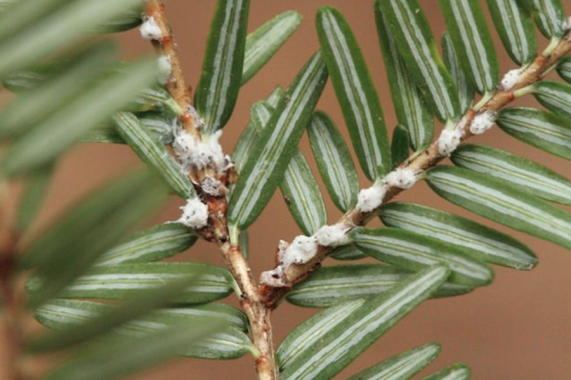
INVASIVE HEMLOCK WOOLLY ADELGID THREATENS MICHIGAN’S FORESTS

Michigan is home to more than 100 million hemlock trees, which provide important habitat for various animals such as deer, birds and fish. The hemlock provides thermal cover for animals, such as the deer in the winter, along with providing protection against erosion on river and stream banks, food for deer and other wildlife, and is an important source of lumber and ornamental value.
But hemlocks are at risk and their loss may mean a lack of habitat for deer and other animals could cause a shift in population and a decrease in hunters and trappers success out in the woods, along with destruction to our beautifully aesthetic forests, which people come to visit from all over the states.
The Hemlock Woolly Adelgid (Adelges tsugae) or HWA is native to East Asia, and was accidentally introduced to North America through Japan. It was first found in the United States in the early 1950’s near Richmond, Virginia, however the pest has now been established in 11 states spreading from Georgia to Massachusetts causing wide spread hemlock destruction with over 50% of the geographic range of eastern hemlock having been impacted.
In North America, the HWA asexually reproduces and can have two generations per year. Between 100 and 300 eggs are laid in the woolly eggs sacs beneath the branches. In the spring time the larvae emerge and can spread on their own, or with the help of the wind, birds or mammals, however when in the nymph stage, the Adelgid is immobile and will settle on a single tree.
The identifying features of HWA can be seen by the presence of its egg sacs, which resemble small tuffs of cotton or white wax clinging to the underside of hemlock branches. The hemlocks who suffer from the pest frequently become a grayish-green rather than the rich dark green color a healthy hemlock would normally be.
The Hemlock Woolly Adelgid feeds on the sap of tender hemlock shoots, during the feeding it may also inject a toxin, which can result in the tree losing needles and not reproducing new growth. In the United States in the northern region where the hemlocks can be found, the typical death range occurs four to ten years after infestation, and the few trees who do survive the infection tend to be very weak and can die from secondary causes.
Michigan has previously dealt with and eradicated infestations in Allegan, Berrien and Emmet counties, and is currently working on an infestation in Ottawa County. To help prevent further spread of the invasive pest in 2002 a quarantine was put in place that makes it illegal to bring hemlock or hemlock material into the state from infected areas in the United States. Along with the quarantine other methods of control include insecticidal soap/horticultural oil which are the safest environmental chemical control method for the Hemlock Woolly Adelgid. These insecticides are non-toxic and are applied to the foliage and kill the insect by smothering it when the spray dries. If you suspect a hemlock is infected you can contact MDARD at 800-292-3939 or email them at MDA-info@michigan.gov .
This article is part of the ongoing series on invasive species funded in part with funds from the Michigan Invasive Species Grant Program through the Departments of Natural Resources, Environmental Quality, and Agriculture and Rural Development

The threat of the Hemlock Woolly Adelgid (HWA) is not yet widely recognized in the Michigan conservation community. But the possible escape of this invasive insect from containment/eradication in western Michigan counties would threaten the survival of all wild hemlocks in the upper Midwest – including Michigan, Wisconsin, Minnesota and southern Canada! For long-term protection of our native hemlock forests, we will need to go beyond short-term chemical applications to establish biological control of HWA in all vulnerable hemlock populations.
The good news is that we now have over 20 years of USDA-supported scientific research to use in this HWA control effort. For example, DNA analysis by USFS researcher Nathan Havill has confirmed that our imported HWA strain (1 of at least 9 in the world) originated in southern Japan. Connecticut researchers have identified and obtained APHIS approval for use of the predator beetle (Sasajiscymnus tsugae) that controls this HWA in Southern Japan (where the native hemlock (Tsuga seiboldii) does not have the high levels of biological resistance to HWA that have been reported for other Asian hemlock species). This USDA-approved predator (St) is a “specialist” predator which requires adelgids to feed and reproduce, and so it is not a threat to other, beneficial native insects.
Biological control will not eradicate HWA! But once established, the St predator can maintain HWA populations at levels that will not threaten the health and well-being of our native hemlocks. USDA labs have developed rearing strategies that have allowed the production and release of millions of these predator beetles on public lands in the eastern US. And the Sasajiscymnus tsugae beetle is also commercially available to private groups and individuals from a Rearing Laboratory in Pennsylvania – Tree-Savers.com
Unlike our experience in the Southeast, where wild hemlocks were buried under an advancing avalanche of HWA, the HWA advance in Michigan and the northern Midwest will likely be slowed by subzero winter temperatures. But this won’t eliminate the need to implement biological control of HWA to protect native hemlocks and their ecosystems. So it is important to include this topic in discussions within the Michigan conservation community about how to participate in protecting hemlock forests by controlling the destructive Hemlock Wooly Adelgid.
For more information on science-based HWA control issues and sources, please consult my non-commercial website: savinghemlocks.org